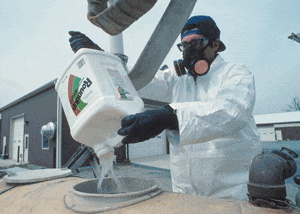By Pamela Coleman, PhD
Farm and Food Policy Analyst
The Cornucopia Institute
 |
Glyphosate is the active ingredient in one of the most heavily used herbicide in the world: Monsanto’s Roundup®. The industry claims that Roundup® is quite safe, but authors of a recent article in the scientific journal Entropy reach a very different conclusion:
“Contrary to the current widely-held misconception that glyphosate is relatively harmless to humans, the available evidence shows that glyphosate may rather be the most important factor in the development of multiple chronic diseases and conditions that have become prevalent in Westernized societies.”[i] [emphasis added]
This is a bold assertion. Is it possible that we are only now realizing the harmful effects of this herbicide that has been in common use since the 1970s? How does glyphosate harm humans? How did we overlook these problems for decades? Read on.
Acute vs. Chronic Toxicity
The acute toxicity of glyphosate is relatively low, meaning that accidentally ingesting it will likely not cause immediate harm. Chronic toxicity—the effects of continually ingesting glyphosate residues in food—is cause for concern. Glyphosate interferes with fundamental biochemical reactions and may predispose humans to obesity, Alzheimer’s, Parkinson’s, and other health problems.
It’s easy to overlook these effects. Toxicity studies on laboratory animals are typically short term, often only a few months. The harm from low-level, chronic exposure can only be seen after a long period of time, often years, or even decades. The real guinea pigs in this case are humans.
From a scientific perspective, it is impossible to prove that a chemical ingested on food can harm a person’s health decades later. However, it is possible to study the specific biochemical action of the pesticide, and then examine the diseases that have been related to malfunction of that biochemical pathway.
Indirect Evidence of Harm: Glyphosate Interferes with Biochemistry of Bacteria
Describing the effects of glyphosate, the Entropy article states: “Negative impact on the body is insidious and manifests slowly over time.”[ii] The authors cite several ways glyphosate may contribute to the chronic diseases that have occurred with increasing frequency as use of the herbicide has increased.
Roundup® kills plants by interfering with a biochemical pathway involved with synthesis of amino acids, called the shikimate pathway. This pathway is not found in humans, therefore it was assumed that glyphosate does not harm humans. The pathway is found in bacteria, however, and humans depend on bacteria in the gastrointestinal (GI) tract to synthesize the essential amino acids.
By interfering with the biochemistry of bacteria in our GI tract, consumption of glyphosate depletes essential amino acids and predisposes humans to a host of chronic health problems. Specifically, glyphosate depletes the amino acids tyrosine, tryptophan, and phenylalanine, which can then contribute to obesity, depression, autism, inflammatory bowel disease, Alzheimer’s, and Parkinson’s.
There is also evidence that Roundup® inhibits cytochrome P450 (CYP) enzymes in plants[iii] and mammals[iv]. The CYP enzymes help to detoxify foreign chemicals (such as pesticides), regulate levels of vitamin D, and control cholesterol in humans.
The combination of ingredients in Roundup® may be even more toxic than glyphosate alone.[v] The surfactants in Roundup® make it an effective herbicide, but also increase its toxicity to animal cells[vi] and bacteria[vii].
Direct Evidence of Harm: Glyphosate Kills Beneficial Bacteria
A study examining the effect of glyphosate on bacteria that grow in the GI tract of chickens found that beneficial bacteria were susceptible, and harmful bacteria were resistant, to glyphosate. The growth of four types of beneficial bacteria—Lactobacillus, Bacillus, Bifidobacterium, and Enterococcus—was reduced at low concentrations of glyphosate. [viii] The same types of beneficial bacteria inhabit the human GI tract, and they are sold over the counter as a probiotic supplement. Some strains are also found in yogurt.
When exposed to the same levels of glyphosate that harmed the beneficial bacteria, several harmful bacteria, including Salmonella, grew successfully. The authors concluded that ingestion of glyphosate can disturb the normal microbial community and predispose chickens to carrying high levels of Salmonella or other harmful bacteria.
A similar study found that glyphosate was toxic to beneficial bacteria in cattle, and hypothesized that glyphosate residues on cattle feed may predispose cattle to infection by Clostridium botulinum, the bacterium that causes botulism.[ix]
Roundup Use Skyrocketing
 |
When Roundup® was first introduced in the 1970s, its use was limited to weeds, because the active ingredient glyphosate kills all plants. That changed with the introduction of crops genetically engineered (GE) to tolerate glyphosate. Glyphosate use has been increasing exponentially. From 2001 to 2007, glyphosate use doubled, reaching 180 to 185 million pounds in the U.S. in 2007.[x] One reason for the increase in herbicide use is the increase in corn acreage to produce the ethanol that is added to gasoline.
Herbicide use is also increasing on crops grown for food. First, glyphosate can now be sprayed over the GE crop itself, whereas previously only the weeds were sprayed. Second, herbicides are now sprayed on crops to kill the foliage just before harvest, particularly potatoes, beans, and grains. These practices increase not only the amount of herbicide sprayed into the environment, but also the amount directly absorbed by the plants that are eaten by humans and livestock.
In response to this scenario, the agrichemical industry requested increases in the tolerance levels for glyphosate, that is, the residues allowed in food and feed. The Environmental Protection Agency (EPA) complied, raising the tolerance levels of glyphosate residue in many crops. For example, the levels for soybean have been doubled, from 20 parts per million (ppm) to 40 ppm.[xi]
This means that the genetically engineered Roundup Ready® crops will have higher levels of glyphosate, even as scientists learn more about the insidious long-term effects of ingesting it.
Conclusion
This article highlights only a few of the scientific studies that show how glyphosate interferes with fundamental biochemical reactions and inhibits the growth of beneficial bacteria. As glyphosate use increases, there is increasing urgency for additional studies to determine the effects of glyphosate consumption over a human life span.
This story originally appeared in The Cultivator, The Cornucopia Institute’s quarterly print publication available to members and online.
[i] Samsel, A., and Seneff, S. 2013. Glyphosate’s Suppression of Cytochrome P450 Enzymes and Amino Acid Biosynthesis by the Gut Microbiome: Pathways to Modern Diseases. Page 1443. Entropy, 15, 1416-1463; doi:10.3390/e15041416
[ii] Samsel, A., and Seneff, S. 2013. Glyphosate’s Suppression of Cytochrome P450 Enzymes and Amino Acid Biosynthesis by the Gut Microbiome: Pathways to Modern Diseases. Page 1443. Entropy, 15, 1416-1463; doi:10.3390/e15041416
[iii] Lamb, D.C.; Kelly, D.E.; Hanley, S.Z.; Mehmood, Z.; Kelly, S.L. Glyphosate is an inhibitor of plant cytochrome P450: Functional expression of thlaspi arvensae cytochrome P45071b1/reductase fusion protein in Escherichia coli. Biochem. Biophys. Res. Comm. 1998, 244, 110–114.
[iv] Hietanen, E.; Linnainmaa, K.; Vainio, H. Effects of phenoxyherbicides and glyphosate on the hepatic and intestinal biotransformation activities in the rat. Acta. Pharmacol. Toxicol. 1983, 53, 103–112.
[v] Kim, Y.H.; Hong, J.R.; Gil, H.W.; Song, H.Y.; Hong, S.Y. 2013. Mixtures of glyphosate and surfactant TN20 accelerate cell death via mitochondrial damage-induced apoptosis and necrosis. Toxicol. In Vitro, 27, 191–197.
[vi] Kim, Y.H.; Hong, J.R.; Gil, H.W.; Song, H.Y.; Hong, S.Y. 2013. Mixtures of glyphosate and surfactant TN20 accelerate cell death via mitochondrial damage-induced apoptosis and necrosis. Toxicol. In Vitro, 27, 191–197.
[vii] Clair, E.; Linn, L.; Travert, C.; Amiel, C.; Séralini, G.E.; Panoff, J.M. 2012. Effects of Roundup and glyphosate on three food microorganisms: Geotrichum candidum, Lactococcus lactis subsp. cremoris and Lactobacillus delbrueckii subsp. bulgaricus. Curr. Microbiol. 64, 486–491.
[viii] Shehata, A.A.; Schrödl, W.; Aldin, A.A.; Hafez, H.M.; Krüger, M. 2013. The effect of glyphosate on potential pathogens and beneficial members of poultry microbiota in vitro. Curr. Microbiol. 66, 350–358.
[ix] Krüger, M.; Shehata, A.A.; Schrödl, W.; Rodloff, A. 2013. Glyphosate suppresses the antagonistic effect of Enterococcus spp. on Clostridium botulinum. Anaerobe 2013, 20, 74–78.
[x] Samsel, A., and Seneff, S. 2013. Glyphosate’s Suppression of Cytochrome P450 Enzymes and Amino Acid Biosynthesis by the Gut Microbiome: Pathways to Modern Diseases. Page 1443. Entropy, 15, 1416-1463; doi:10.3390/e15041416
[xi] Federal Register, May 1, 2013, page 25396. http://www.gpo.gov/fdsys/pkg/FR-2013-05-01/pdf/2013-10316.pdf

